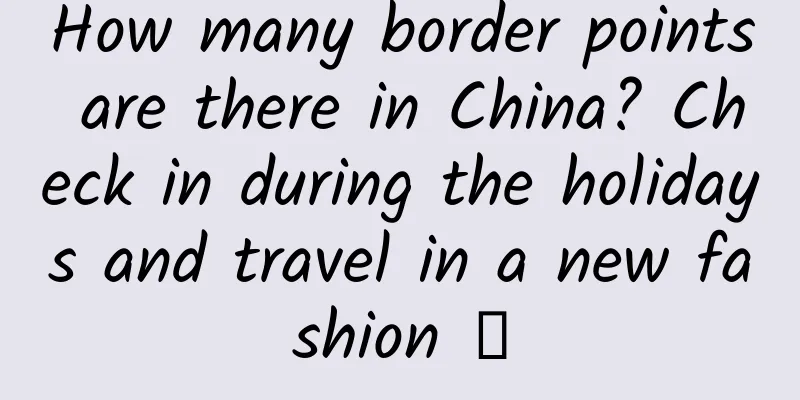How many border points are there in China? Check in during the holidays and travel in a new fashion →

|
China has a vast territory with different conditions in different places. The place where three provinces meet was called "the thoroughfare of three provinces" in ancient times. Because of its unique geographical location, it has a natural, historical and cultural characteristics different from other places. It has become a place for economic exchange, cultural communication and customs integration, forming a unique landscape and leaving a deep mark in China's history and geography. Written by | Ajian How many border points are there in China? How many are there? If I tell you now, it will be meaningless. You can count them yourself or ask your relatives or friends to count them. If you are good at math, you may be able to use formulas and theorems to deduce the approximate number. China has 23 provinces, but Taiwan and Hainan are islands and do not border other provinces - we will talk about it later after land reclamation or building of cross-sea bridges. China has 4 municipalities (the newer one is Chongqing), which are also provincial-level administrative regions, and their borders with other provinces are also provincial boundaries. Don't underestimate the municipality of Chongqing, its area (more than 80,000 square kilometers) is larger than Ningxia, Taiwan, and Hainan. China has 5 autonomous regions, which are also provincial-level administrative regions, and their borders with other provinces are also provincial boundaries. China also has 2 special administrative regions, but they are only adjacent to Guangdong, so there is no question of the border between three provinces. Therefore, it does not seem so difficult to count how many points of border between three provinces there are in China. How many are there? I counted them with my whole family's fingers at first; later, I almost walked them out. Let me tell you how many tri-state borders there are in the United States. There are 50 states in the United States, but in addition to tri-state borders, there are also several four-state borders - they look like a cross (longitude and latitude) on the map, so how many different tri-state borders are there at each four-state border? 4. So there are a lot of tri-state borders in the United States. China does not have a four-province border - I mean a four-province border in the strict sense. The borders of Anhui, Shandong and Henan provinces and Anhui, Shandong and Jiangsu provinces, no matter how close they are, are still 10 to 20 kilometers apart. No matter how good a rooster's voice is, it is difficult to crow in these four provinces. But some provinces in China have enclaves, such as a small enclave in Hebei, including Xianghe County, Dachang Hui Autonomous County and Sanhe City, which is embedded between Beijing and Tianjin, so it adds variables to the junction of the three provinces. For example, a small enclave in Xichuan, Henan, is located in Yun County, Hubei, and does not form a junction of the three provinces. Guess how many junctions of the three provinces have been added by the establishment of the municipality of Chongqing - Chongqing borders Shaanxi, Hubei, Hunan, Guizhou and Sichuan. It is easy to count on the map, but it would be troublesome to go and see them in person - I hope that the speed of my search for the junction of the three provinces can keep up with the speed of the motherland's establishment of new municipalities or provinces. There are usually three-province boundary monuments (piles) at the junction of three provinces. Strictly speaking, to find the border of three provinces, you should reach the border point of three provinces - it has longitude and latitude and corresponding landmarks. Most of the landmarks of the border of three provinces in China are three-province border monuments (piles), which are generally triangular columns, engraved with the full names or abbreviations of the three adjacent provinces, and "State Council" and the year, month and day. But some of the border points of three provinces are in the river, such as the border point of Yunnan, Sichuan and Guangxi, where it is impossible to erect a monument, and there is no "floating monument" - it is a three-river mouth, you can dive into the three intersections, and I almost tried it. At the junction of Anhui, Shandong and Jiangsu, there is a well, also called the Three Provinces Well. The names of the three provinces are written on the side walls of the well, and a small pavilion was later added on the well. Drinking a sip of water from this well is equivalent to drinking water from three provinces. The monument at the junction of Hubei, Henan and Shaanxi is a conical triangular stone - the designer may have done this intentionally, fearing that people would step on it firmly; in fact, the triangular prism monument with eaves in the past was quite generous. Most of the monuments at the junction of the three provinces are triangular columns with flat tops, generally less than 1 meter above the ground, and made of cement or local stone. I have never been to the borders of Tibet, Xinjiang, Qinghai, and Tibet, Xinjiang, and Gansu. I have only been to the counties closest to the two borders, so I don't know what these two borders are. The former is at the junction of the Altun Mountain No Man's Land and Hoh Xil - the most I have been to is Aqikekule Lake in Altun, and the latter is west of Dangjin Pass - the most I have been to is the mining area nearby. But I heard that a boundary survey team of the State Council has been engaged in the placement of boundary markers between Qinghai and Xinjiang, so there should be two boundary markers at different three intersections. I didn't find the junction of the three provinces of Hubei, Henan and Anhui. I guess there might be a three-province boundary marker there, but we heard from the locals at Huangbai Mountain or Shizi Peak at the junction that there is no marker and that the mountain is called "Sanguan". I don't quite believe it, but my feet hurt so much that I couldn't climb up, otherwise I would have erected one for the State Council for free. What does it mean when three provinces meet? Many provincial boundaries are divided by clear geographical features, such as mountain ridges and rivers; some are divided by large artificial buildings, such as the Great Wall and canals. Thus, the differences range from climate to products, from diet to habits. Many provincial boundaries were the borders of ancient vassal states, such as Mount Tai between Qi and Lu, and the Yellow River between Qin and Jin; or they were the borders between farming and nomadic peoples, such as the Great Wall between Jin and Mongolia. Therefore, the differences range from language and culture to daily customs. Many provincial boundaries divide the major ethnic groups, so the differences range from religious beliefs to blood race. The junction of three provinces often radiates different languages or dialects, marriage customs or funeral ceremonies, facial features or skin colors, likes and dislikes or worries and joys, beliefs or taboos. Therefore, except for sparsely populated areas, most of the junctions of the three provinces have become more convenient places for economic exchange, cultural communication, and customs integration between one province and the other two neighboring provinces. For example, many of the junctions of the three provinces have unclear dialects, or are dominated by the dialects of the province with better economy; for example, many of the junctions of the three provinces have a high marriage rate, similar residential architectural features, and similar types of diseases. The three-province thoroughfare in the past and the three-province market today have attracted many capable people to converge at the highest point of the three junctions; of course, there are also opposite examples, such as in the past, criminals fled to the junction of the three provinces and had a chance to breathe when the three provinces were not yet coordinated. Why are most of the old revolutionary bases located at the junction of three provinces? The Huangma Uprising after the First Revolutionary Civil War took place at the junction of Hubei, Henan and Anhui provinces; Yan'an, the revolutionary holy land during the War of Resistance Against Japanese Aggression, was located at the junction of Shaanxi, Gansu and Ningxia provinces; the Shanxi-Chahar-Hebei Border Region ("Cha" was Chahar Province at the time, and the provincial government was once in Zhangjiakou), which played a major role in the North China battlefield during the War of Liberation, was also located at the junction of the three provinces. The borders of the three provinces are mostly areas with harsh geographical conditions and weak economic environment, where transportation is inconvenient, industry and commerce are lacking, and administration is difficult to reach - the so-called "no man's land". This is in line with the party's strategic policy of opening up revolutionary bases in the countryside and "surrounding the cities with the countryside". There are even more old revolutionary bases at the junction of two provinces, the most typical of which is Jinggang Mountain at the junction of Hunan and Jiangxi. Today, traveling to many places at the junction of three provinces is like receiving revolutionary traditional education. For example, Hong'an County (formerly known as Huang'an County) at the junction of Hubei, Henan and Anhui provinces has produced more than a hundred generals, and Jinzhai County has produced seventy or eighty. Of course, these places are located in deep mountains with high forest coverage, and have become tourist areas that people yearn for - the mountainous areas where the revolution was the most turbulent back then are now the scenic spots with the best scenery. For example, the Nanling area at the junction of Guangdong, Hunan and Jiangxi provinces was the base of the northern Guangdong guerrillas and the southern Jiangxi guerrillas before 1949. The mountains there are barren and the roads are dangerous, making it easy to defend but difficult to attack. Wanshi Mountain there now has a tourist highway and a star-rated hotel, and the monument at the junction of the three provinces has also become a famous attraction. Therefore, when talking about traveling to the old revolutionary areas, the first thing that pops into some people’s minds is "red" and "party history", but those who know a little history know that it is by no means a small scenery like Guilin or a soft scenery like Hangzhou, but a solid vision and grand scenery. "One foot in three provinces" is actually vanity Small people may have great ambitions, but in fact it is vanity, which is what Lu Xun called the spiritual victory method. Of course, the glorious part of vanity can balance a person's grievances, losses, and sorrows. For example, you are just an ordinary person in a certain province, but today you step on the sign at the junction of three provinces, and you feel proud. I know a few tourist spots at the junction of three provinces. To cater to the psychology of tourists, they put up a sign of "Stepping on three provinces", so that tourists can step on three provinces without spending too much money. Tourism is about spending money to have fun - that chair was sat on by a general, so I should sit on it too; that pine tree was taken by a leader, so I should take a photo with him too; the monument at the junction of three provinces can naturally have similar gameplay. A few friends and I were at a boundary monument where three provinces meet, rolling dice and drinking as punishment. Each person drank for a province. The dice hit the top of the monument and bounced up before falling into a region of a province. Someone laughed and drank as punishment, as if they were rewarding the drink. My friends and I have long wanted to do some fun activities with the Three Provinces Intersection Monument. For example, we can go find some food coupons from various provinces 40 years ago (before the food coupons were abolished, each province had its own food coupons) and display or auction them at the intersection of the three provinces; for example, we can practice the dialects of the three provinces we chose this time in advance and say a sentence in three dialects at the intersection; for example, three groups from three provinces will head to the same intersection and meet. Someone else has come up with a romantic idea, but it is not easy to implement. In short, there are many things to play at the intersection of the three provinces, but the current domestic activities of playing the three intersections are relatively simple. Geographical types at the junction of three provinces Those located in the plains include the Hebei, Shandong and Henan Intersection Monument in the farmland, the Hubei, Henan and Shaanxi Intersection Monument in the streets, the Beijing, Tianjin and Hebei Intersection Monument beside the national highway (this refers to the intersection near Anping Town, there are three other intersections in Beijing, Tianjin and Hebei, near Xiaodiantun, near Dalinghou and near Hongshimen), the Mongolia, Jilin and Liaoning Intersection Monument beside the railway, and so on. Located in grassland or wasteland, such as the intersection of Mengjihei. Located in deserts or wastelands, such as the intersection of Mengshan, Ningxia. Those located in the river channel, such as the intersection of Hubei, Anhui and Jiangxi in the Yangtze River, the intersection of Zhejiang, Shanghai and Jiangsu on the Taipu River, the intersection of Yunnan, Guangxi and Guizhou on the Nanpan River, the intersection of Yunnan, Guizhou and Sichuan on the Chishui River, and so on. Located on the top of the mountain, there are such monuments as the Mongolia-Liaoning-Hebei intersection monument, the Beijing-Tianjin-Hebei intersection monument near Hongshimen, the Guangdong-Hunan-Jiangxi intersection monument, and the Hubei-Henan-Anhui intersection monument. Those located on or near the Great Wall include the Mongolia, Shanxi and Hebei Triple Intersection Monument at the foot of the Great Wall (but there is a newer Triple Intersection Monument on the side of the new national highway nearby), the Beijing-Tianjin-Hebei Triple Intersection Monument on top of the Great Wall beacon tower on the mountain ridge near Hongshimen, and the Mongolia, Shaanxi and Shanxi Triple Intersection Monument on the side of the Great Wall and on the bank of the Yellow River. The Shandong-Henan-Anhui Crossing Monument is located in the semi-swamp of the old Yellow River course. It is located at the intersection of Tibet, Xinjiang and Qinghai, at the junction of the Altun Mountain No Man's Land and the Hoh Xil No Man's Land. The above are just examples. It can be found that the three intersections are mostly in geographically distinct places, either bounded by mountain tops or ridges, or by rivers. It is rare for the three intersections to be in places where people live, such as the three intersection monuments of Hubei, Henan and Shaanxi in Bailang Town and the three intersections of Guizhou, Hunan and Guangxi in Sanxing Street in the north of Dudong Town. Boundary demarcation of course defines ownership, such as grassland, forest products, minerals, and even historical sites. Therefore, it is inevitable that two or three provinces sharing the same border will have disputes over boundary ownership, and there have even been incidents of unauthorized movement or destruction of boundaries. Some incidents have become so serious that they have to be directly handled by the boundary survey department of the State Council. Checking in at the three-province boundary monument is becoming a trend I know that many people have walked along the borders of three provinces or even three regions, which is much cheaper and easier than walking along the borders of three countries. But I don’t know anyone who has systematically walked along the borders of three provinces in China—Xu Xiake in ancient times didn’t, nor did Yu Chunshun and Liu Yutian in modern times. Of course, people who work in related fields in land departments and geographical research institutions don’t count. I haven’t seen the book “China’s Three-Provincial Borders”, but if there is no capable person to survey and draw the “Atlas of China’s Three-Provincial Borders” (one for each of the three intersecting provinces, including three counties in each of the three adjacent provinces and the three nearest settlements, etc.), don’t blame me for being the first to fly (the final result is this book). It is becoming fashionable to visit three intersection monuments. Some people even collect expired and invalid three intersection monuments (such as the three intersection monuments between the original Xicheng, Dongcheng and Xuanwu districts in Beijing). If the three-province intersection monument is far away, you can start from the three districts or three counties intersection monument. For example, on the south side of Wangjing Tower on Jianfu Mountain in Beijing, there is a monument for the intersection of Shijingshan, Mentougou and Haidian districts, which is also a monument erected by the State Council. You may encounter the three-province intersection monument between Beijing Pinggu, Tianjin Jixian and Hebei Xinglong when climbing the wild Great Wall. It is not difficult to visit a place where three provinces meet, just like it is not difficult to climb a famous mountain. "This mountain looks higher than that mountain", after visiting a place where three provinces meet, most people will think about the next one, just like climbing high and looking far is also addictive. "Sitting one and looking at three" has already taken advantage of two; then two and three, three times three is nine, it is worth it. This article is authorized by China Science and Technology Press to be excerpted from "Sitting One and Looking Three: Searching for the Borders of Three Provinces in China" Special Tips 1. Go to the "Featured Column" at the bottom of the menu of the "Fanpu" WeChat public account to read a series of popular science articles on different topics. 2. Fanpu provides a function to search articles by month. Follow the official account and reply with the four-digit year + month, such as "1903", to get the article index for March 2019, and so on. Copyright statement: Personal forwarding is welcome. Any form of media or organization is not allowed to reprint or excerpt without authorization. For reprint authorization, please contact the backstage of the "Fanpu" WeChat public account. |
>>: Chang'e 6 is launched today! Reviewing Chang'e's 17-year lunar exploration feat!
Recommend
Movies and TV shows show people vomiting blood in various ways... Is it really reasonable?
An actor's self-cultivation includes not only...
Air conditioning was invented to "save you"? Wrong! The truth is...
In the hot summer, air conditioners have become a...
Can humans really achieve immortality? Let's start with HeLa cells
"Eternal life" has always been an impor...
Bleder tutorial takes off in 2021 [good quality and material]
Bleder tutorial takes off in 2021 [good quality a...
Hammer phone high standard drop test
The drop test of the Hammer phone is finally comp...
With 70 million users in 5 years, how did Xiaohongshu succeed in the e-commerce red ocean?
Do you still remember Xiaohongshu, the cross-bord...
Asia-Pacific region can take six measures to build climate-resilient green roads
Sustainable road development balances economic gr...
Shadow video live streaming
Introduction to the live streaming resources of S...
Microbes: We are the engine of soil material circulation
Microorganisms are everywhere in nature, and soil...
Aerospace helps flood control? "Sky Eye" rushes to help from thousands of miles away, and an unmanned "savior" appears in the sky!
Recently, due to extreme weather such as heavy ra...
It's a fake volcano that spits mud!
Mud volcano is a unique geological phenomenon. It...
Fish bone stuck in throat, swallow rice and drink vinegar?
Popular saying: Many people have experienced fish...
The tulips that were once "priceless" turned out to be infected with a virus?
When people talk about the Netherlands, they natu...
How to make information flow video ads more efficient?
Some advertisers have already reaped the benefits...
China Academy of Information and Communications Technology: 2015 Internet of Things White Paper
The China Academy of Information and Communicatio...



![The fierce competition between the two brightest minds made the chemical bond theory compatible [Part 1]](/upload/images/67f206819f85f.webp)





